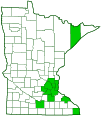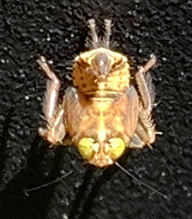coppery leafhopper
(Jikradia olitoria)
Conservation • Description • Habitat • Ecology • Distribution • Taxonomy
|
|
||||||||||||||
Description |
Coppery leafhopper is a common, medium-sized, slender leafhopper. It occurs throughout the eastern half of the United States and in adjacent Canadian provinces. In Minnesota it has been recorded only in the southeast quarter of the state. Little is known of the biology of leafhoppers in the subfamily Coelidiinae. Coppery leafhopper is said to feed on woody species. In 1975 it was suggested that the subspecies Jikradia olitoria floridana was a vector of strawberry pallidosis. This was later rejected when in 2006 the greenhouse whitefly Trialeurodes vaporariorum was discovered to be the true vector of the disease. Coppery leafhopper adults are ¼″ to 5⁄16″ (6 to 8 mm) in length and variable in color. They are usually light brownish-gray to medium brownish-black, sometimes dark and bluish, sometimes entirely light brownish-yellow. Females always have pale wing bands. Males are always dark brown or rusty brown and have no pale bands. The head is narrower than the exoskeletal plate covering the thorax (pronotum). It is broadly rounded in front and is crowned just in front of the eyes. There are two large compound eyes and two tiny simple eyes (ocelli). The antennae are short and bristle-like. The plate on the lower face (clypeus) is long and narrow with parallel sides. The pronotum does not extend over the abdomen. The width in the middle equals the width of the crown. The plate between the wing bases (scutellum) is large and triangular. It is slightly longer in the middle than the pronotum is wide. There are two pairs of wings, and they are held tent-like over the body when at rest. The forewings (hemelytra) are thickened and long, extending almost to the tip of the abdomen. The veins on the hemelytra are distinct. The hindwings are thin, membranous, a little shorter than the hemelytra, and concealed beneath the hemelytra. The fourth segment (tibia) of the hind leg has two rows of spines. The last part of the leg (tarsus), corresponding to a foot, has three segments. |
Size |
Total length: ¼″ to 5⁄16″ (6 to 8 mm) |
Similar Species |
Habitat |
|
Ecology |
Season |
June to September |
Behavior |
|
Life Cycle |
|
Nymph Food |
|
Adult Food |
Plant juices from the stems and leaves of woody plants |
Distribution |
||
|
Sources Medler, John T.. (1942). The leafhoppers of Minnesota. Retrieved from the University Digital Conservancy, https://hdl.handle.net/11299/204089. |
|
| 7/19/2024 | ||
Occurrence |
||
Common |
||
Taxonomy |
|
Order |
Hemiptera (True bugs, Hoppers, Aphids, and Allies) |
Suborder |
Auchenorrhyncha (true hoppers) |
Infraorder |
Cicadomorpha (spittlebugs, cicadas, leafhoppers and treehoppers) |
Superfamily |
Membracoidea (leafhoppers and treehoppers) |
Family |
|
Subfamily |
Coelidiinae |
Tribe |
Teruliini |
Genus |
Jikradia |
This species was formerly placed in the genus Coelidia. In 1979 all New World species were transferred into the new genus Jikradia. The genus Coelidia now contains only Old World species. |
|
Subordinate Taxa |
|
Three subspecies were described based on coloration. A recent review of the subspecies showed that individuals with the different color variations had the same male genitalia, and probably did not deserve subspecies ranking. |
|
Subordinate Taxa |
|
|
|
Synonyms |
|
Coelidia olitoria Jassus borealis Jassus floridanus Jassus fuscipennis Jassus olitorius Jassus semifasciatus Jassus subbifasciatus Jikradia olitorius |
|
Common Names |
|
coppery leafhopper |
|
Glossary
Clypeus
On insects, a hardened plate on the face above the upper lip (labrum).
Hemelytron
The forewing of true bugs (order Hemiptera), thickened at the base and membranous at the tip. Plural: hemelytra.
Ocellus
Simple eye; an eye with a single lens. Plural: ocelli.
Pronotum
The exoskeletal plate on the upper side of the first segment of the thorax of an insect.
Scutellum
The exoskeletal plate covering the rearward (posterior) part of the middle segment of the thorax in some insects. In Coleoptera, Hemiptera, and Homoptera, the dorsal, often triangular plate behind the pronotum and between the bases of the front wings. In Diptera, the exoskeletal plate between the abdomen and the thorax.
Visitor Photos |
||
Share your photo of this insect. |
||
This button not working for you? |
||
Alfredo Colon |
||
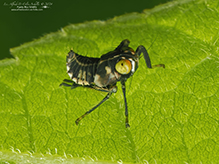 |
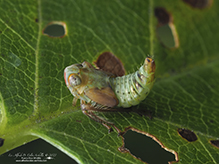 |
|
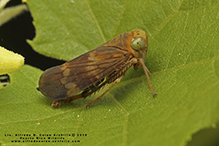 |
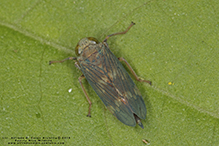 |
|
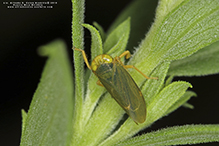 |
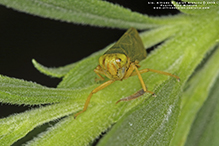 |
|
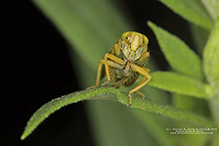 |
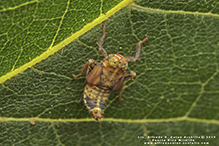 |
|
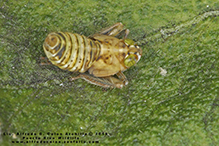 |
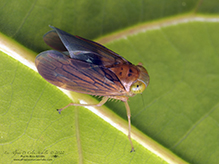 |
|
Brian B. Gibbens |
||
Mystery Bug My son spotted a very strange bug on our deck…. It was very tiny, about the size of a grain of rice, and it hopped like a grasshopper. Any idea what it might be? Maybe a nymph of some larger bug? I have never seen anything else quite like it. |
||
Babette Kis |
||
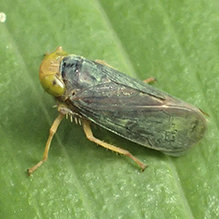 |
||
Jikradia olitoria coppery leafhopper Jikradia olitoria found on Barnes Prairie, Racine Co., Wisconsin on Polygonatum biflorum, Solomon's seal. |
||
MinnesotaSeasons.com Photos |
||
|
||
|
||

Slideshows |
|

Visitor Videos |
||
Share your video of this insect. |
||
This button not working for you? |
||
|
Other Videos |
||
Coppery Leafhopper (Coelidia olitoria ) |
About
Aug 4, 2010 One beautiful leafhopper...looks like it is wearing a copper suit of armor. |

Visitor Sightings |
||
Report a sighting of this insect. |
||
This button not working for you? |
||
| Alfredo Colon 7/6/2024 |
Location: Albany, NY |
 |
| Alfredo Colon 8/26/2022 |
Location: Albany, NY |
 |
| Alfredo Colon 8/3/2022 |
Location: Albany, NY |
 |
| Babette Kis 9/25/2022 |
Location: Barnes Prairie hedgerow, Racine Co., Wisconsin Jikradia olitoria found on Barnes Prairie, Racine Co., Wisconsin on Polygonatum biflorum, Solomon's seal. |
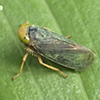 |
| Alfredo Colon Summer 2019 |
Location: Woodbury, Minnesota |
 |
| Alfredo Colon 8/29/2019 |
Location: Woodbury, Minnesota |
 |
| Alfredo Colon 8/9/2019 |
Location: Woodbury, Minnesota |
 |
| Alfredo Colon 8/7/2019 |
Location: Woodbury, Minnesota |
 |
| Alfredo Colon 8/2/2019 |
Location: Woodbury, Minnesota |
 |
MinnesotaSeasons.com Sightings |
||
|

Created: 7/10/2020 Last Updated: © MinnesotaSeasons.com. All rights reserved. |
